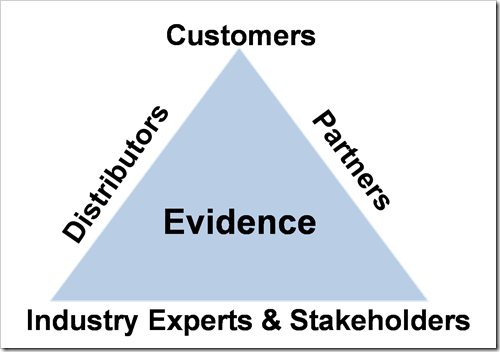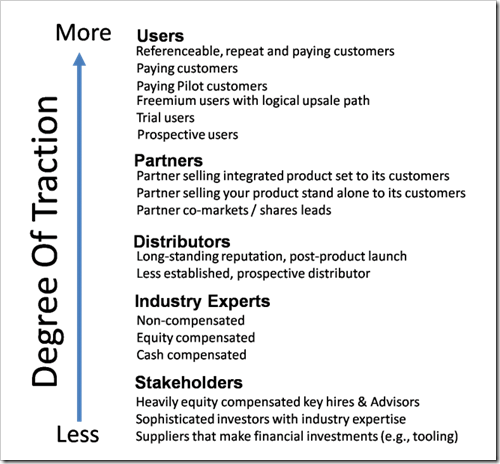Investors, MVPs and Evidence of Traction
Yesterday, I was talking to a startup founder about their MVP and they said something that finally got me to write this post:
"I have a few investors interested but they want to see a product."
In Building Your MVP as a Non-Technical Startup Founder, I mentioned that before you build your Minimum Viable Product (MVP), you need to be really clear on your purpose.
In most cases, when you are building your MVP, you are trying to prove out certain startup metrics such as:
- Cost of Customer Acquisition
- Conversion Rates / Pricing
- Viral Coefficient
in order to get those numbers in front of investors so that you have evidence of traction and can show that you can begin to build out more of the real product and begin to scale the business.
It is almost never the case that you are building an MVP to "show" to an investor the product itself. Yes, the investor may literally have said to you:
"That is something I'd seriously think about investing in when you have your product built."
But the reality is that they don't mean that. Two aspects to this:
- You can let an investor see your product via a mockup or clickable prototype.
- If you do build the MVP and show it to them, they will ask you about your metrics. They really want metrics, not a product.
A Mockup is Enough to Show the Product
Most investors can look at a mockup or clickable prototype and have a pretty good sense of the product. They may wonder if it can be built technically, but I (or other CTOs) can answer that question without building any code.
Cases Where a Mockup is Not Enough
There are a few cases where mockups or clickable prototypes may not be enough:
- Usability, interaction design, etc. For example, the iPod won not because of better features and functions. It won because of interface, ease of use. To get an investor excited about another MP3 player at the time, they would have needed to play with the interface. That said, you likely could have still come up with some cheaper way than building the iPod.
- Results of Algorithms. Often you can't tell if something like a search engine or matching algorithm is really going to have better results until you use it. You may have to build something out to show it working for someone to evaluate whether it really works better than what else exists.
I would guess that this represents less than 5% of startups.
Investors Really Want Evidence of Traction
So you built your MVP; you bring it to the investor; you demo it; and I will guarantee they will ask you:
"So how many users do you have?
How much is it costing you to get users?
How much are you making from your users?"
And other similar questions. Yes, they are happy that you have your product built and that does make it much more investable. But now that you have a product, you should be able to show that people want to and/or are willing to pay to use it.
Bad News? Not Really
At first you may be thinking that this is all bad news. Wow, now Tony is telling me that not only do I need to build my MVP, but I need to actually show evidence of traction. That's an even tougher hurdle. Yes, that's correct. Sorry, but that's the reality.
However, the good news is that for most investors, you can certainly change the question and get a lot more information without ever building the MVP. The real question you should be asking is "When I've built this product and show you the following metrics, would you invest?" The "this product" will be a well formulated mock-up or clickable prototype. If you don't have that, then you will naturally let the investor off the hook by saying, show me the product.
I actually think you can push the conversation pretty far with most investors and a few good mockups. No, you won't know if you will really get a check - most investors are hard to actually get a check from - but you will have a pretty good indication.
Bottom line is that before you go and build your MVP:
- Define your MVP really well on paper and Document Your MVP for a Developer
- Do Your Homework Before You Develop Anything
- Make Sure You look at Questions Developers May Have Forgot to Ask a Startup Founder
- Figure out the Evidence of Traction you really need
- Get a Technical Advisors: Every Web/Mobile Startup Must Have One
- Test all of this with Investors
Additional Sources
How Much Traction is Enough for Investors?But never forget that traction is necessary, but may not be sufficient, to lower the risk perception of investors, and assure an investment. The quality of the team, and overall financial health are equally important, as well as how your offering compares to competitors.
Now that You've Got MVP, It's Time to Think About MVC
You can't raise money on achieving an MVP. Investors demand more than that.
As Steve Blank likes to say:
A Startup Is a Temporary Organization Designed to Search
for A Repeatable and Scalable Business Model
The unfortunate reality is - an MVP is not the above! Yet most of the newly minted entrepreneurs I've met think their job is nearly done when they've found MVP - they think they can go build a pitch off their early MVP and raise money!
A startup does require MVP but it is much more than just MVP. The problem is that MVP means early adoption of product and its features, maybe even some who will pay. But it doesn't tell you how many people will do it in the long term and whether this can support the company (the people and operations within) that is behind it.
What The Heck Does “Traction” Really Mean To A VC?
Great analysis from John Greathouse:


1 comment:
Tonny,
Another great post for founders and startups. Sometimes founders, particularly new ones, need to hear the message many times for it to sink in. Thanks for keeping us on track. I will publish this again on Launch America to help all the new founders and their startups. Great work and keep it coming.
Nick
Post a Comment